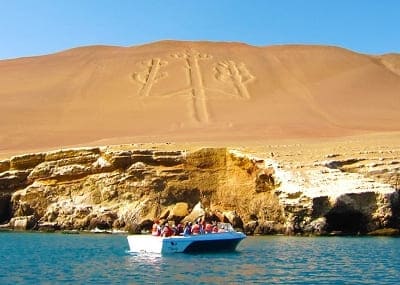Everything You Need to Know Before Visiting the Ballestas Islands
The Ballestas Islands, known as the “Little Galápagos of Peru,” are one of the most spectacular destinations on Peru’s southern coast. Located off the shores of Paracas, these rocky formations host an incredible variety of marine wildlife, ancient history, and unique landscapes. If you’re planning your trip, here’s everything you need to know to fully enjoy this unforgettable experience.
What Exactly Are the Ballestas Islands?
They are a group of small islands and rocky islets rising from the Pacific Ocean, about 20 km from Paracas. These islands are uninhabited by humans but home to thousands of marine animals thanks to the rich ecosystem created by the cold Humboldt Current.
A Marine Wildlife Sanctuary
Among the species you can observe are:
- Humboldt Penguins: the main stars, easily recognizable.
- Sea Lions: hundreds resting on rocks or swimming alongside boats.
- Common Dolphins: occasionally seen accompanying the boats.
- Boobies, Cormorants, Pelicans, Inca Terns, Gulls, and many other seabirds flying around the islands in search of food.
Its waters are also full of fish, crustaceans, and mollusks, making the Ballestas Islands one of the richest marine ecosystems in South America.
The Mystery of the Paracas Candelabra
Before reaching the Ballestas Islands, during the boat ride, one of the first attractions is the enigmatic Paracas Candelabra geoglyph, visible on the sand dunes. Its exact origin remains unknown, but several theories exist:
- Some believe it belonged to the Paracas culture as an astronomical or ritual symbol.
- Others link it to ancient sailors as a navigational guide.
- There are even esoteric theories linking it to extraterrestrial visitors.
Regardless of its origin, the Candelabra impresses with its size (over 120 meters long) and excellent preservation through time.
What Is the Ballestas Islands Tour Like?
Duration: Approximately 2 hours.
Mode: Group tour on speedboats (12-30 passengers approx).
Departure times: 8:00 am, 9:00 am, and 10:00 am (the best times for marine weather).
The navigation is usually calm, though waves may vary depending on the season. During the ride, guides provide detailed explanations in Spanish and English about the wildlife and natural phenomena.
Best Time to Visit the Ballestas Islands
Paracas enjoys privileged coastal desert weather almost year-round. However:
- November to April: Sunny days, perfect for clear photos.
- May to September: Slightly cloudier skies due to coastal mist, but tours operate normally.
During high season (January-March and national holidays), it’s highly recommended to book your tours in advance to secure spots.
Can You Land on the Islands?
No. For environmental conservation reasons, physical access to the islands is prohibited. Boats circle the rock formations, allowing close observation of the animals without disturbing their natural habitat.
Is the Boat Ride Safe?
Yes, authorized companies follow strict safety protocols:
- Mandatory life jackets.
- Trained crew members.
- Constant monitoring of weather conditions.
If you're prone to seasickness, consider taking anti-nausea medication beforehand.
Practical Tips to Fully Enjoy the Tour
- Bring sunscreen (even on cloudy days).
- Wear a hat or cap with a strap (the wind is constant).
- Light clothes but a jacket for the boat ride (it may feel cold on the water).
- Protect your camera or phone from salt spray (a waterproof bag is useful).
- The best photo spots are along the boat sides.
The Importance of Guano in Peru’s Economic History
The Ballestas Islands, along with other guano islands along the coast, were at the center of the "Guano Boom" in the 19th century. This natural fertilizer, rich in nitrogen and phosphorus, was exported massively to Europe and the U.S., generating one of Peru’s largest economic incomes for decades.
Frequently Asked Questions (FAQ)
Is it suitable for young children? Yes, it’s family-friendly. However, for babies under 1 year, it may not be ideal due to boat vibrations.
What happens if it rains or the weather turns bad? Port authorities suspend tours if the sea isn’t safe. This is rare but possible.
Can you see whales? Yes, during certain months (August-October), humpback whales can sometimes be spotted migrating along the coast.
What Other Tours to Combine with the Ballestas Islands?
When visiting the Ballestas, it’s ideal to combine your day with:
- Paracas National Reserve: Red Beach, Cathedral viewpoint, Yumaque Beach.
- Huacachina Tour: Ica’s famous oasis with sandboarding and dune buggies.
- Vineyards in Ica: Wine and pisco tasting tours.
Why Is It Called the "Peruvian Galápagos"?
Though smaller in scale, the Ballestas Islands share characteristics with Ecuador’s Galápagos Islands:
- Great diversity of free marine wildlife.
- Partial endemism in some bird species.
- Wind and sea-eroded rocky landscapes.
Their accessibility from Lima makes them a perfect alternative for experiencing a marine sanctuary without a long or expensive trip.
Final Conclusion
The Ballestas Islands are truly one of Peru’s natural gems—accessible, impressive, and educational. Whether you’re a nature lover, a family traveler, or a photographer seeking unique postcards, this tour will exceed your expectations. If you’re in Paracas, you simply can’t leave without visiting these stunning marine jewels of the Pacific. 🐧🌊


